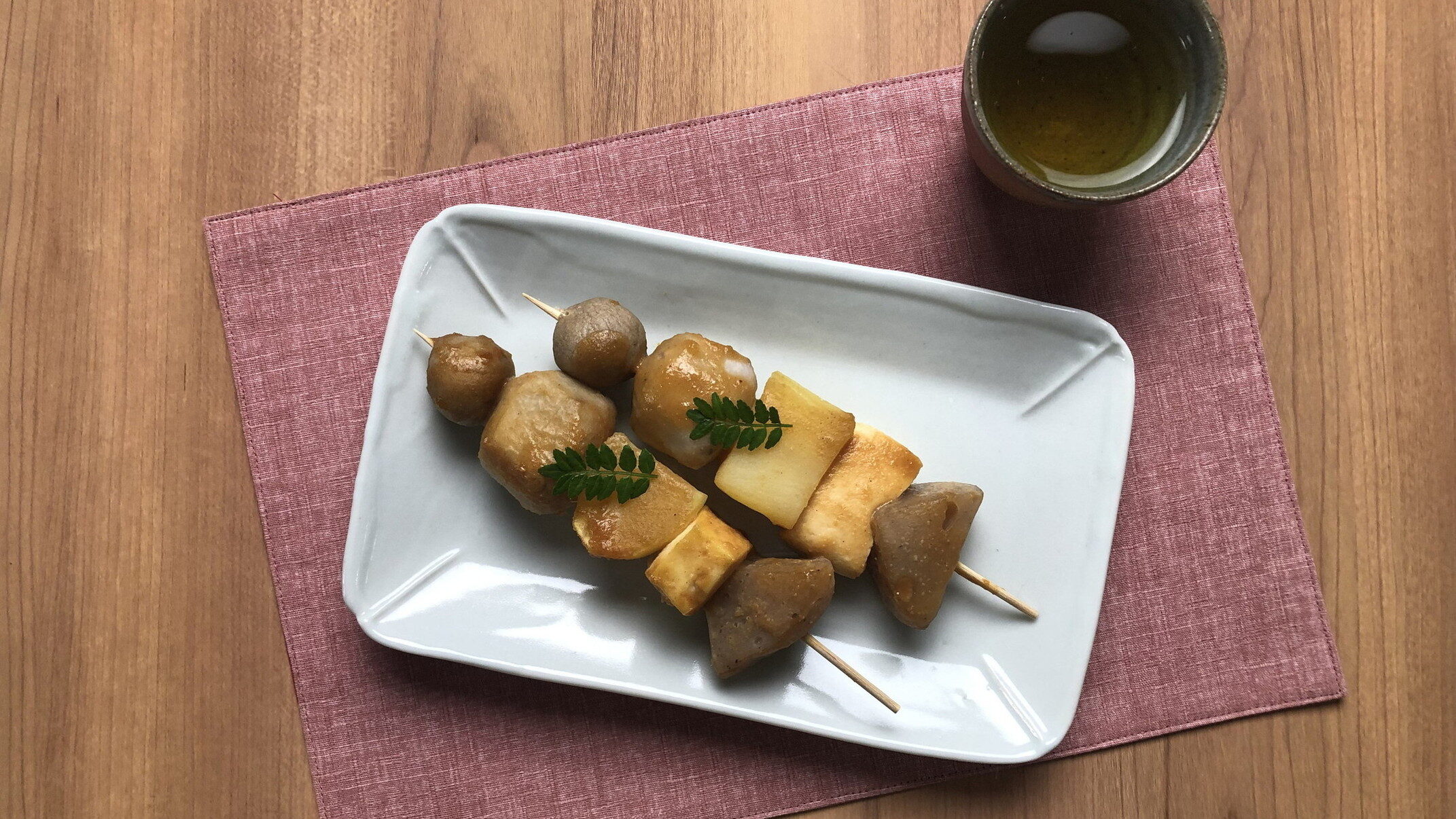
Alright, let’s head to the Iya region of Tokushima and talk about a fun and rustic dish called “Iya no Dekomawashi”! Imagine skewered bites of potato, soba dumplings, tofu, and konnyaku, all grilled over an open fire with a sweet and savory miso glaze. It’s a dish with a name that tells a story, and it’s a great way to taste the local flavors of Iya. Let’s get into the details!
Dish Name: Iya no Dekomawashi
- Region / Location: Iya region, Miyoshi City
- Primary Area of Tradition: Iya region, Miyoshi City
- Main Ingredients: Potato, konnyaku, tofu, etc.
How It’s Eaten / Served
Iya no Dekomawashi is a local dish from the Iya region of Miyoshi City, featuring bite-sized pieces of potato, soba dumplings, “iwa-dofu” (firm tofu), and round konnyaku skewered and grilled with a miso glaze. The skewers are traditionally grilled around an “irori” (sunken hearth), and you have to turn them constantly to cook them evenly. The way you turn the skewers is said to resemble the way the heads of “Deku” puppets (from Awa Ningyo Joruri, the local puppet theater) move, which is where the name “Dekomawashi” comes from.
The potatoes used in Dekomawashi are a local variety called “Goshu-imo,” which are small and perfect for skewering. “Iwa-dofu” is a firm, dense tofu, also made in the Iya region, that holds up well to grilling. Soba (buckwheat) flour is also produced in the area, and it’s used to make the soba dumplings. So, Dekomawashi is a dish that really showcases the local specialties of Iya.
Cultural Background and Preservation
Dekomawashi was mainly a home-cooked dish, enjoyed as an everyday meal. The ingredients were typically skewered in a specific order: potato, tofu, and then konnyaku at the bottom. The konnyaku, being less slippery, acted as a sort of stopper to keep the other ingredients from sliding off the skewer. While the ingredients were generally the same, some households would make skewers entirely of Goshu-imo, especially during potato harvest season.
To make Dekomawashi, the potatoes and konnyaku are boiled beforehand, and the soba flour is kneaded with water and shaped into dumplings. These, along with bite-sized pieces of iwa-dofu, are skewered and grilled over an open fire. Once they’re lightly grilled, they’re coated with a miso glaze and grilled again, turning the skewers constantly to ensure even cooking.
Since fewer homes have irori hearths these days, Tokushima Prefecture provides recipes for making Dekomawashi in an oven or grill in their “Tokushima no Kyodo Ryori” (Tokushima’s Local Cuisine) publication, making it easier for people to enjoy this local dish. It’s also served in elementary and junior high school lunches, helping to pass on the tradition to the next generation.
Additional information:
- Irori (囲炉裏): A traditional Japanese sunken hearth.
- Deku (でく): A wooden puppet.
- Awa Ningyo Joruri (阿波人形浄瑠璃): A form of Japanese puppet theater from Tokushima Prefecture.
- Goshu-imo (ごうしゅいも): A small variety of potato grown in the Iya region.
- Iwa-dofu (岩豆腐): Firm, dense tofu made in the Iya region.
- Konnyaku (こんにゃく): A jelly-like food made from the starch of the konnyaku potato.
- Miso: A fermented soybean paste used for seasoning.
The information about regional cuisine featured on this website (Piggy's Grandma of Japan) is summarized and adapted from the Ministry of Agriculture, Forestry and Fisheries of Japan (MAFF) website, "Our Regional Cuisines"Additional commentary is provided based on the unique experiences and perspectives of the site's editors.
The copyright for the original content regarding regional cuisine belongs to the Ministry of Agriculture, Forestry and Fisheries of Japan.
The summaries and adaptations published on this site are intended for informational purposes only. Piggy's Grandma of Japan does not guarantee the accuracy or completeness of this information. For the most accurate and complete details, please refer to the original pages on the MAFF website.

